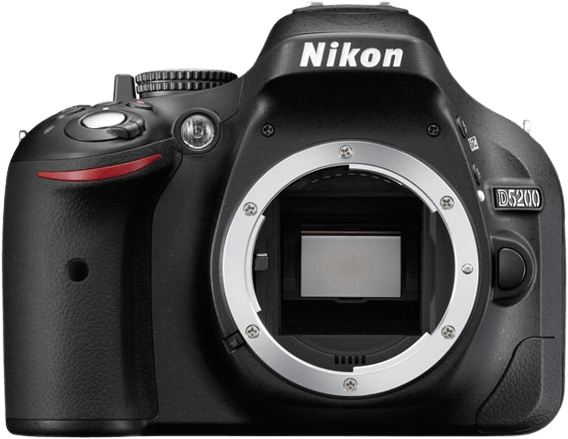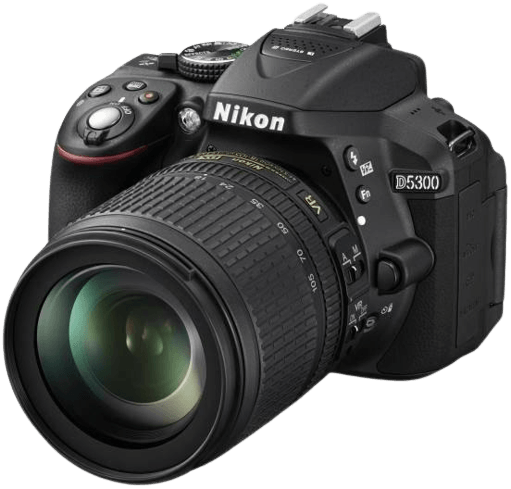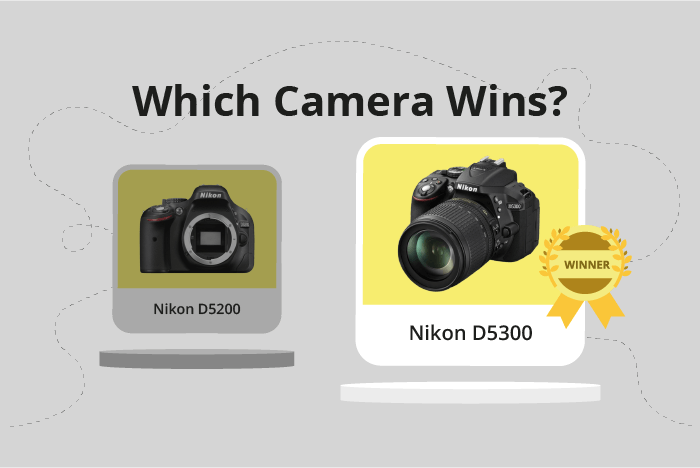Nikon D5200 vs D5300 Comparison
Nikon D5200

Nikon D5300

The Nikon D5300 edges out the Nikon D5200 with a score of 57/100 compared to 56/100. Both cameras are DSLR models released in 2012 and 2013, respectively. They share similar dimensions, with the D5300 being slightly smaller at 125 x 98 x 76mm compared to the D5200’s 129 x 98 x 78mm. The D5300 also has a weight advantage, weighing 480g compared to the D5200’s 555g.
The D5300’s higher score comes from its better performance and lighter weight. However, the D5200 has a slightly larger size, which may offer a more comfortable grip for some users. The D5200 also had a higher launch price of $897, compared to the D5300’s more affordable $800.
Taking these factors into account, the Nikon D5300 emerges as the superior choice due to its better performance, lighter weight, and lower launch price. The Nikon D5200 may still appeal to those who prefer a slightly larger camera.
Nikon D5200 vs D5300 Overview and Optics
Upon comparing the optics of the Nikon D5200 and Nikon D5300, both cameras receive a score of 65/100. This shows that there is no clear winner in terms of optics, as the scores reflect the similarities in their specifications.
Both cameras have a CMOS sensor, APS-C sensor size, Nikon F DX lens mount, and no image stabilization. They also share a shooting speed of 5 frames per second and are equipped with 24-megapixel sensors. This indicates that the two cameras share many core features that affect image quality.
However, there are some differences between the two models. The Nikon D5200 has a 24.1-megapixel sensor and an Expeed 3 processor, while the Nikon D5300 has a 24.2-megapixel sensor and an Expeed 4 processor. The D5300’s slightly higher megapixel count and upgraded processor provide better image processing capabilities. This results in marginally improved image quality and faster performance.
On the other hand, the Nikon D5200 has a DXOMARK sensor score of 84, which is one point higher than the Nikon D5300’s score of 83. This suggests that the D5200 may have a slight advantage in terms of sensor performance.
Taking these factors into account, it is evident that the Nikon D5300 has a minor advantage in image processing capabilities, while the Nikon D5200 has a slightly better sensor performance. However, the differences are minimal, and both cameras have highly similar optics. Considering these similarities and minor differences, potential buyers should weigh other factors such as price, additional features, and personal preferences when making a decision between the Nikon D5200 and Nikon D5300.
Nikon D5200 vs D5300 Video Performance
When comparing the video capabilities of the Nikon D5200 and the Nikon D5300, both cameras have an equal score of 70/100. This means that there is no clear winner in terms of video performance. The similarities between the two cameras are evident, as they both offer Full HD video resolution with a maximum video dimension of 1920 x 1080, and a maximum video frame rate of 60fps. Additionally, both cameras have built-in time-lapse functionality.
Despite their identical scores, there may be some differences in the video features of the Nikon D5200 and the Nikon D5300. However, these differences are not significant enough to declare one camera as superior to the other. Both cameras provide excellent video quality and performance, making them suitable for various video recording needs.
In terms of the losing camera, it is difficult to pinpoint any areas where one camera is better than the other, as they both have the same video score. This indicates that both cameras have similar video capabilities and performance, making them equally suitable for capturing high-quality videos.
Based on the specifications and video scores, it is evident that both the Nikon D5200 and the Nikon D5300 are excellent choices for those looking to capture high-quality videos. With their identical video specifications and performance, users can confidently choose either camera without sacrificing video quality or functionality. The decision between the two cameras may ultimately come down to factors outside of their video capabilities, such as price or additional features.
Nikon D5200 vs D5300 Features and Benefits
The Nikon D5300 outperforms the Nikon D5200 with a feature score of 46/100, compared to the D5200’s score of 41/100. Both cameras share several specifications, including the lack of a touchscreen, the presence of a flip screen, and no Bluetooth capabilities. However, the D5300 has additional features that contribute to its higher score.
The D5300’s screen size is larger at 3.2 inches, compared to the D5200’s 3-inch screen. Additionally, the D5300’s screen resolution is higher at 1,037,000 dots, as opposed to the D5200’s 921,000 dots. These differences result in a more comfortable and clearer viewing experience on the D5300.
Moreover, the Nikon D5300 includes GPS and WIFI capabilities, which the D5200 lacks. These features enhance the user experience by allowing for easier geotagging and sharing of photos.
On the other hand, the Nikon D5200 does not offer any significant advantages over the D5300 in terms of features. The lower feature score reflects this fact. The main difference between the two cameras lies in their additional specifications, with the D5300 offering a more comprehensive set of features.
Considering the differences in screen size, screen resolution, GPS, and WIFI capabilities, the Nikon D5300 emerges as the better option when comparing features. The D5200 falls short in these areas, making it a less appealing choice for those seeking a camera with a robust set of features.
Nikon D5200 vs D5300 Storage and Battery
The Nikon D5300 outperforms the Nikon D5200 in storage and battery, with a score of 29/100 compared to the D5200’s 27/100. Both cameras share common specifications, including a single memory card slot and support for SD, SDHC, and SDXC memory cards. Neither camera offers USB charging capabilities.
The D5300 has a longer battery life, providing 600 shots per charge, while the D5200 gives 500 shots. This difference makes the D5300 more suitable for extended shooting sessions. The D5300 uses the EN-EL14a battery type, which contributes to its increased battery life.
There are no specific advantages in storage and battery for the D5200 over the D5300. The D5200 uses the EN-EL14 battery type, which provides a shorter battery life compared to the D5300.
Considering these points, the Nikon D5300 is the better choice for those prioritizing longer battery life and more shots per charge. The Nikon D5200 does not offer any advantages in storage and battery over the D5300.
Nikon D5200 vs D5300 – Our Verdict
Are you still undecided about which camera is right for you? Have a look at these popular comparisons that feature the Nikon D5200 or the Nikon D5300:

